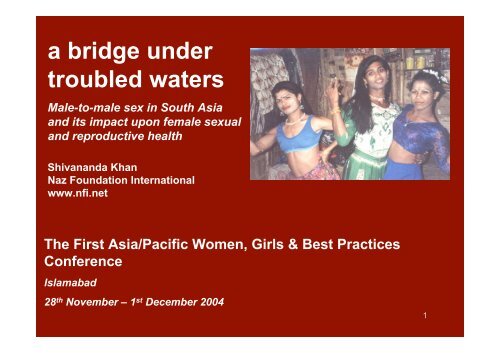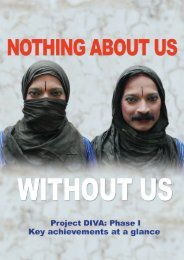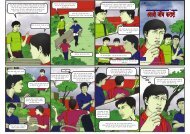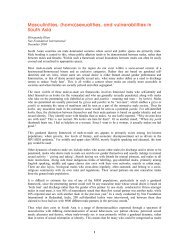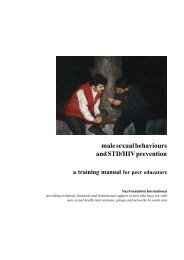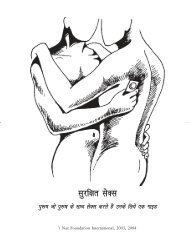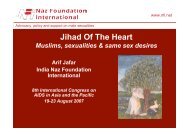male sex - Naz Foundation International
male sex - Naz Foundation International
male sex - Naz Foundation International
Create successful ePaper yourself
Turn your PDF publications into a flip-book with our unique Google optimized e-Paper software.
a bridge under<br />
troubled waters<br />
Male-to-<strong>male</strong> <strong>sex</strong> in South Asia<br />
and its impact upon fe<strong>male</strong> <strong>sex</strong>ual<br />
and reproductive health<br />
Shivananda Khan<br />
<strong>Naz</strong> <strong>Foundation</strong> <strong>International</strong><br />
www.nfi.net<br />
The First Asia/Pacific Women, Girls & Best Practices<br />
Conference<br />
Islamabad<br />
28 th November – 1 st December 2004<br />
1
The MSM context in South Asia<br />
There appears to be three main frameworks of MSM, with an<br />
emergent fourth in major urban areas among the upper middle<br />
classes<br />
• Gendered framework<br />
Male to <strong>male</strong> desire based on feminised gendered roles and<br />
Identification - <strong>sex</strong>ual acts based on gender roles, i.e. man/not-man<br />
• Discharge framework<br />
Male to <strong>male</strong> <strong>sex</strong>ual behaviours arising from immediate access,<br />
opportunity, and “body heat”. They involve <strong>male</strong>s/men from the<br />
general <strong>male</strong> population<br />
• Age-related framework<br />
This reflects the “beardless youth” construct of <strong>male</strong>-to-<strong>male</strong> desire,<br />
where the older man forms a pederastic relationship with a<br />
younger <strong>male</strong> (the Halekon of Afghanistan)<br />
2
The MSM context in South Asia<br />
Many <strong>male</strong>s from the general <strong>male</strong> population will also access<br />
feminised-identified <strong>male</strong>s (kothis/zenanas/metis/hijras) for anal/oral<br />
<strong>sex</strong> . These <strong>male</strong>s do not see themselves as “homo<strong>sex</strong>uals”, or even<br />
their behaviour as “homo<strong>sex</strong>ual”, since they take on the “manly”<br />
penetrating role in <strong>male</strong> to <strong>male</strong> <strong>sex</strong><br />
And of course not to forget, <strong>male</strong>s/men in all <strong>male</strong> institutions, such as<br />
prisons, the uniformed forces, colleges, university, schools, religious<br />
institutions, and just places where <strong>male</strong>s congregate<br />
3
The MSM context in South Asia<br />
• Emergent gay framework<br />
Male to <strong>male</strong> desire farmed by <strong>sex</strong>ual<br />
orientation. Primarily used by middle<br />
and upper classes. Such gay identified<br />
men usually seek other gay identified<br />
men as <strong>sex</strong> partners<br />
4
Sociocultural frameworks of <strong>male</strong>-to<strong>male</strong><br />
<strong>sex</strong>ual availability in South Asia<br />
• Patriarchal social structures<br />
within a culture that is<br />
homosocial and<br />
homoaffectionalist<br />
• Public domain as a <strong>male</strong><br />
space<br />
• Gender segregation, with<br />
fe<strong>male</strong>s socially policed and<br />
difficult to <strong>sex</strong>ually access<br />
• Poverty and personal<br />
survival strategies<br />
5
Sociocultural frameworks of <strong>male</strong>-to<strong>male</strong><br />
<strong>sex</strong>ual availability in South Asia<br />
• Mass <strong>male</strong> migration and shared spaces<br />
• A dominant masculinity which sees a MAN as the penetrating<br />
<strong>male</strong> and who can maintain his “manliness” even when he<br />
penetrates another <strong>male</strong><br />
• A gendered construction where <strong>male</strong>s who are <strong>sex</strong>ually<br />
penetrated are constructed as “not-men”<br />
• Non-vaginal <strong>sex</strong> not seen as <strong>sex</strong>, but as play, masti, discharge<br />
6
Why do <strong>male</strong>s have <strong>sex</strong> with <strong>male</strong>s?<br />
• Desire for other <strong>male</strong>s<br />
–gender/orientation<br />
• Desire for specific acts – anal/oral<br />
• Pleasure and enjoyment from<br />
discharge – “body heat” – also play<br />
curiousity<br />
• Wives do not do anal or oral <strong>sex</strong> –<br />
ashamed to ask<br />
7
Why do <strong>male</strong>s have <strong>sex</strong> with <strong>male</strong>s?<br />
• Males are easier to access –<br />
shared beds and spaces<br />
while fe<strong>male</strong>s are more<br />
socially policed and more<br />
difficult to access<br />
• Protecting a girls virginity –<br />
maintaining chastity<br />
• For money<br />
8
Male-to-<strong>male</strong> <strong>sex</strong> prevalence<br />
India<br />
• 25% of medical students at Patna Medical College in a 1992 survey<br />
revealed that they had same-<strong>sex</strong> relationships (Wyatt, 1993)<br />
• Of the 1500 men who replied to a questionnaire in an English<br />
men’s magazine in India, Debonair, 29.5% stated that had <strong>sex</strong> with<br />
another man before the age of 20 years (Roy Chan, et al. 1998)<br />
Pakistan<br />
• 20% of men in one rural area have <strong>male</strong>-to-<strong>male</strong> <strong>sex</strong><br />
• 40% of men living in a Karachi squatter settlement had <strong>male</strong>-to<strong>male</strong><br />
<strong>sex</strong><br />
• 72% of truck drivers in central Karachi had <strong>sex</strong> with other <strong>male</strong>s,<br />
while 76% had <strong>sex</strong> with fe<strong>male</strong> <strong>sex</strong> workers<br />
July 1996 edition of AIDS Analysis Asia<br />
9
Male-to-<strong>male</strong> <strong>sex</strong> prevalence<br />
In Bangladesh, ICDDR,B reported in the 2003 behavioural<br />
surveillance report:<br />
22% of rickshaw pullers had <strong>male</strong>-to-<strong>male</strong> <strong>sex</strong><br />
In Sri Lanka, 50% of <strong>male</strong> university students reported that their first<br />
<strong>sex</strong>ual experience was with another <strong>male</strong><br />
Youth and Sexual Risk in Sri Lanka, Women and AIDS Research Programme,<br />
Washington DC, <strong>International</strong> Centre for Research on Women, 1997, Silva,<br />
K.T. et al<br />
In other words, <strong>male</strong>-to-<strong>male</strong> <strong>sex</strong> with high risk activities<br />
is very common and not just within an isolated “target<br />
group”<br />
10
Why work with <strong>male</strong>-to-<strong>male</strong> <strong>sex</strong>ual<br />
behaviours and HIV?<br />
MSM is not an exclusive group,<br />
or target group, isolated from<br />
The general population<br />
It involves <strong>male</strong>s from the<br />
general <strong>male</strong> population along<br />
with <strong>male</strong>s with specific<br />
gender/<strong>sex</strong>ual orientations<br />
Male-to-<strong>male</strong> <strong>sex</strong> is a bridging behaviour also<br />
It involves <strong>male</strong>s, fe<strong>male</strong>s, and children<br />
11
Key recommendations for action<br />
• The social construction of the dominant masculinity<br />
needs to be challenged and addressed as a part of any<br />
gender sensitivity to address <strong>sex</strong>ual violence and<br />
stigma against feminised <strong>male</strong>s and fe<strong>male</strong>s<br />
• Assistance to support self-help HIV/AIDS service<br />
provision by and for vulnerable <strong>male</strong> populations, i.e.<br />
kothis, hijras, gay-identified men<br />
• Sexual health strategies developed for fe<strong>male</strong> partners<br />
of MSM<br />
12
Key recommendations for action<br />
• Unprotected anal <strong>sex</strong> as a<br />
risk behaviour needs to be<br />
included in all <strong>sex</strong>ual health<br />
education programmes for<br />
the general public, all<br />
occupational groups, and<br />
other vulnerable <strong>male</strong><br />
populations<br />
• STI treatment centres skilled<br />
up to deal with anal STIs,<br />
MSM, and fe<strong>male</strong> partners of<br />
MSM<br />
13
Human Rights also means<br />
Sexual Health Rights for All<br />
14


